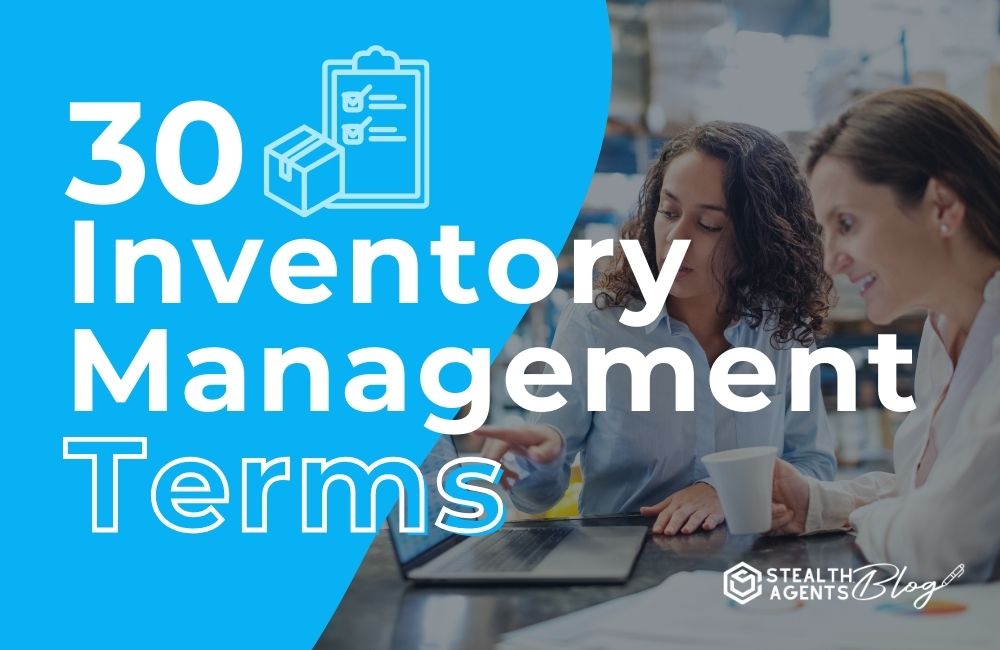Imagine you’re at the helm of a bustling warehouse, witness to a symphony of bustling workers, the clink of goods being shelved, and the ballet of forklifts maneuvering between aisles. While it might resemble controlled chaos, there’s a meticulous choreography at play, conducted by a set of terms as intricate as the business of inventory management itself. Dive into the depths of your stockroom with us as we break down 30 essential terms that are the bedrock of efficient inventory orchestration.
Inventory Management Terms
The Basics: Understanding the Groundwork
Let’s start where every business plan begins— the basics. Understanding these core elements lays the foundation for streamlined inventory systems and efficient stock control.
1. Stock-Keeping Unit (SKU): The go-to identifier, your SKU is like the DNA of your product, unique to your business, and often used for tracking inventory.
2. Reorder Point (ROP): It’s the inventory level that means “time to order more.” Go past this point, and you might face stockouts.
3. Economic Order Quantity (EOQ): The magic number that balances ordering costs and holding costs, finding the most cost-effective quantity to reorder.
4. Safety Stock: The cushion between ROP and stockout, ensuring unexpected demand or delays won’t leave you empty-handed.
5. Carrying Cost of Inventory (CCOI): Think of it as the rent your warehouse charges per item, including storage, insurance, and the money tied up in stock.
Demand Dynamics: Riding the Tides of Consumer Need
The task of predicting consumer demand is like weather forecasting, but instead of meteorological maps, you’ll need these terms in your toolkit.
6. Lead Time: The span between order and delivery, crucial for timing ROP correctly and avoiding stockouts or overstock.
7. Demand Forecasting: A gospel sung by retailers, it’s the art (and science) of predicting how many units of a product will sell over a certain period.
8. Seasonal Demand: Those specialized items or spikes in sales that are as predictable as summer or winter, but just as necessary to prepare for.
9. Stockout: It’s retail purgatory. When demand outstrips your supply, leaving your shelves bare, waiting for a restock that can’t come soon enough.
10. Dead Inventory: Unused and often outdated, dead inventory can be a real financial vampire, sucking resources from modern, salable goods.
Inventory Technologies: Tools of the Trade
Today’s warehouses are far cries from dusty, forgotten storage rooms. They’re humming with technology. Familiarize yourself with these gadgets to ensure peak performance.
11. Barcode and RFID Systems: The superhero duet of inventory management, they speed up scanning and tracking, making manual counts a thing of the past.
12. Just-In-Time (JIT) Inventory: The wave of the future/present, aiming to reduce the carrying cost by delivering inventory exactly when needed.
13. First-In, First-Out (FIFO) and Last-In, First-Out (LIFO): No, we aren’t dancing in stockrooms. These are methods of valuing your inventory for accounting purposes.
14. Inventory Management Software (IMS): The maestro behind the scenes, conducting all the moving parts, automating orders, and providing data for decision-making.
15. Barcoding/RFID Scanners: Your orchestra’s interpreters, they translate the inventory language written in barcodes and RFID tags.
Metrics that Matter: Keeping Score in the Warehouse
In a world where data reigns supreme, keeping tabs on the numbers is like maintaining a pulse on your business’s health.
16. Inventory Turnover Ratio: This is the heart rate of your business. It measures how many times you sell and replace your inventory in a year.
17. Holding Period: The number of days an inventory sits in the warehouse, providing a gauge for cost efficiency and stock performance.
18. Stock-to-Sales Ratio: Indicating how well you’re aligning purchases with sales, this ratio is crucial for not overinvesting in sluggish products.
19. Cycle Counting: A perpetual stocktake, using the ABC method (categorizing items by value/importance) to ensure a regular check without disrupting operations.
20. Gross Margin Return on Investment (GMROI): This metric quantifies your profit in relation to stock investment, helping you optimize your inventory for maximum return.
Flow and Philosophy: Battling Obsolescence and Beyond
Here we delve into the philosophy of inventory—its lifecycle, its purpose, and its eventual fading into the annals of business history.
21. Slow-Moving Stock: These are the snails of your inventory, taking longer to leave the shelves and requiring particular attention to avoid overinvestment.
22. Obsolescence: When goods become yesterday’s news, it’s a financial clock ticking. Managing it involves strategies like discounting, repurposing, or donation.
23. Stockflow: This is the dance of inventory, the dynamic and unpredictable movement of your items from order to usage.
24. Stock Keepingness: Not quite a néologisme in the world of inventory, it’s the process of keeping stock “ready” for when the customer chorus calls for their goods.
25. Inventory Planning: This is where you channel your inner Nostradamus and plot the future demand and supply of your goods months or years ahead.
Global Goods: Inventory in an International Context
With today’s sprawling supply chains, understanding the global lingo is as important as knowing your ABCs.
26. Cross-Docking: The fast lane of inventory management, where goods go from inbound to outbound with minimal storage in between.
27. Multi-Channel Inventory Management: How you keep your ducks in a row when you’re selling in physical stores, online, and maybe even by carrier pigeon.
28. International Commerce Commission (ICC) Incoterms: This global commerce shorthand outlines the rights and obligations of buyers and sellers in international trade.
29. Harmonized System (HS) Codes: Essential for customs, these codes classify goods in international trade to maintain consistency across borders.
30. Customs Brokerage: Your global inventory whisperer, handling the nitty-gritty of customs procedures and ensuring goods make it across borders smoothly.
Conclusion: The Symphony of Inventory Management
From the nascency of a purchase order to the dusk of your goods’ obsolescence, understanding inventory management is like knowing the notes to a vital business symphony. Each term learned is a crescendo towards harmony within your warehouse and throughout your entire supply chain. So go forth, armed with this lexical lexicon, and conduct the mélange of movement within your inventory with acumen and agility. After all, a warehouse is not a sole operation—it’s part of a global ensemble.
The truest maestros of inventory are those who know the parts, know the players, and understand the score. Embrace the rhythm, and may your business enjoy a perpetual baroque of prosperity.











